Fino all’ 8 maggio 2011, a Firenze sarà possibile visitare la mostra SUSPENSE – SCULTURE SOSPESE, presso lo spazio EX3 in zona Gavinana. In esposizione sono presenti noti artisti dello scenario internazionale che amano introdurre nella loro poetica il concetto della sospensione, lo stare a mezz’aria, quella sensazione di volo tra terra e cielo. Il contesto bianco della location rende il tutto ancora più suggestivo: opere come corpi, rimangono sospese, silenziose eppur presenti, imponenti, impossibile non ammirarle.
Nell’atrio d’ingresso, proprio vicino ai lucernari, uno stormo di sculture di cemento sorvolano lo spazio. E’ Synclastic/Anticlastic del messicano Héctor Zamora da interpretare non solo come stormo di uccelli, ma anche come un banco di mante o addirittura un’invasione aliena. Un ragionamento che si fonda sul concetto di migrazione, esodo e sul contrasto tra pesantezza del materiale usato e leggerezza della sospensione.
La più grande istallazione è Clues (2010) di Franco Menicagli. Schienali, testiere, gambe e sedili si confondono, si intrecciano, si legano e si assemblano grazie a sottilissime assi di legno flessibili che formano disegni sinusoidali nell’aria. Il pavimento si smaterializza e il nuovo piano di riferimento sono le pareti, la funzione primaria degli oggetti smembrati non esiste più, è un capriccio formale.
Tomas Saraceno con la sua Biosphere 06 (2009) è una delle attrattive principali in mostra. Una grande sfera trasparente con all’interno la vita, una pianta fiorita costantemente alimentata da acqua. Il tutto poeticamente sospeso e racchiuso in una ragnatela i cui fili interagendo creano delle maglie, che a loro volta interagendo con l’ambiente circostante costiuiscono una potente e leggerissima struttura al cui centro è posta una sfera vitale. E’ un giardino in sospensione, una parte delle citta futuribili concepite dall’artista argentino.
Un altro giardino è proposto da Claire Morgan con Garden (2010), un’opera straordinaria in cui si manifestano la misura dell’uomo e la forza della Natura. l’armonia delle foglie di ligustro infilate una ad una su fili trasparenti secondo una precisa griglia modulare costituente due prismi a base quadrangolare intersecati verticalmente, viene distrutta dal vortice creato dal volo di due passerotti che si inseguono.
Alzando lo sguardo su giardino si notano delle strutture che sembrano nuvole, i Cloud clusters (2005) di Pae White. Gabbie di ferro colorato poste ad un’elevata altezza che creano un nuovo tipo di spazialità. L’artista per ottenere queste forme rettangolari ha rivestito degli scatoloni di cartone con intrecci di filo di ferro, successivamente incendiati per farne rimanere solo la struttura esterna colorata, pronta per imprigionare le nuvole.
Tessuti stracciati, piombo, zavorre e fili di ferro costituiscono la tenda No man’s land (2010) di Cornelia Parker. E’ un riparo armonico con un vasto apparato decorativo che ricorda motivi ornamentali di terre lontane che però l’artista vuole caratterizzare con un significato distruttivo, funereo, una trappola per uomini, la cui negatività è insita in ognuno dei materiali usati.
Di tutt’altra opinione Jorge Pardo che in Unititled (2009) realizza uomini e donne mixando arte, design e architettura. Silhouette cave di policarbonato creano volumi corporei che prendono vita grazie alla luce interiore, il soffio vitale, l’organo vitale posto al centro e la sospensione aerea inoltre le eleva simbolicamente anche dalla dimensione terrena.
Tra le altre grandi opere presenti ci sono: Soap Bubble Skin (2007) di Luca Trevisani un enorme intreccio di lamine di legno ripiegate come un infinito nodo di Moebius che simboleggia le relazioni tra uomo e natura; While nothing happens baby (2010) di Ernesto Neto la gigante scultura in lycra con protuberanze riempite di sabbia e spezie che simula il tessuto epidermico permeabile, assorbe e secerne fluidi; Lapses (2010) di Alexandra Bircken, un patchwork con brandelli di tessuto e vestiti che piano piano collassa dalla sua struttura; The great disarray swindle (2009) di Tobias Rehbeger, un ammasso aggrovigliato di cavi collegati con nastri adesivi fluorescenti in cui sono incastrate lampade bianche, è la filosofia dell’artista che prende forma, quando ad un oggetto funzionale si associa una ricerca estetica, questo diventa opera d’arte.
Tra le opere più piccole troviamo: Soap film models (after Otto Frei) (2010) di Tobias Putrih, sculture di filo rigido piegato da immergere in vasche di acqua/sapone per creare superfici animate, un omaggio all’architetto Frei Paul Otto che ha fondato il suo studio formale proprio sulle bolle di sapone; Presence at night (2010) di Bojan Sarcevic, rami sottili sui quali l’artista ha collocato capelli umani per creare una tensione formale al limite tra staticità e dinamismo come una frusta in tiro; You’ve really fucked up this time (2008) di Beth Campbell, struttura di fili di acciaio che rappresentano le complesse mappe mentali della stessa artista che si sviluppano tridimensionalmente come i mobili di Calder; Tomorrow will be like today (2008) di Hans Schabus, uno sgabello artigianale di uno scultore italiano che negli anni lo ha usato cambiandone il rivestimento, che adesso sollevato da terra sembra essersi liberato del peso del suo padrone e ne vuole racconta la storia attraverso ogni materiale utilizzato per la sua realizzazione.




Infine l’italiana Daniela De Lorenzo che è presente in mostra con due opere particolari che si concentrano sulla figura umana e sul concetto di sospensione. Nel bassorilievo Escamotage (2010) prende vita la sperimentazione della lavorazione a strati del feltro che fa emergere dal fondo il corpo di un contorsionista nel punto massimo di elevazione ripreso da una sequenza fotografica di Muybridge del 1887, mentre in Falsetto (2010) l’impronta su feltro del corpo dell’artista viene scomposta e articolata con pieghe e cuciture come in una composizione musicale.
Until May 8, in Florence you can visit the exhibition SUSPENSE – SUSPENDED SCULPTURES at Ex3 in Gavinana zone. On display there are international artists who like to insert in their poetry the concept of the suspension, staying in the air, that feeling of flying between earth and sky. The white background of the location makes it even more impressive: works like bodies are suspended, they are silent but you can feel their presence, it’s impossible not to admire them.
In the entrance hall a flock of concrete sculptures are flying over the space. It’s Synclastic / Anticlastic the work by the Mexican artist Hector Zamora to be interpreted not only as a flock of birds, but also as a school of manta rays or even an alien invasion. A thought founded on the concept of migration, exodus and the contrast between lightness of the suspension and the heaviness of the material used.
The largest installation is Clues (2010) by Franco Menicagli. Backrests, bed heads, legs and seats are assembled with thin wooden boards that form flexible sinusoidal patterns in the air. The floor is disappearing and the new reference plane are the walls. The primary function of the dismembered object no longer exists.
Tomas Saraceno with its Biosphere 06 (2009) is one of the main attractions on display. A large transparent sphere with a flowering plant constantly fed by water in the inside. All poetically suspended and enclosed in a black web whose threads interacting create mesh, which in turn interact with the environment creating a powerful and lightweight structure. It’s a garden of the future cities conceived by the Argentine artist.
Another garden is proposed by Claire Morgan in Garden (2010), an extraordinary work which shows the “measure” of modern man and the strength of nature. The harmony of privet leaves, strung one by one on transparent wires according to a precise grid forming two prisms intersected vertically, is destroyed by the vortex of two sparrows flight.
Looking up Claire Morgan’s garden you can see the Cloud clusters (2005) by Pae White. These colored iron cages, placed at an high altitude, create a new type of space. The artist obtained these rectangular shapes covering cardboard boxes with iron wire, then burned it up to keep only the exterior web, ready to trap the clouds.
Torn tissue, lead, ballast and wire are the materials used for the tent No Man’s Land (2010) by Cornelia Parker. It ‘s a large shelter with harmonious decorative ornaments reminiscent of faraway lands, but the artist wants to characterize it with a destructive sense, funereal, like a trap for men, whose negativity is inherent in each of the materials used.
Jorge Pardo had a completely different opinion in Untitled (2009) making men and women with a mix of art, design and architecture. Silhouette create hollow polycarbonate body volumes that come to life thanks to an inner light and the air suspension symbolically raises the body from the earthly dimension.
Among the bigger works there are: Soap Bubble Skin (2007) by Luca Trevisani a huge network of strips of wood bent like a Moebius infinite knot that symbolizes the relationship between man and nature; While nothing happens Baby (2010) by Ernesto Neto, the giant sculpture in lycra filled with sand and spices that simulates the human permeable skin that absorbs and secretes fluids; Lapses (2010) by Alexandra Bircken, a patchwork with scraps of fabric and clothing that slowly collapses from its structure; The great disarray Swindle (2009) by Tobias Rehbeger, a pile of tangled cables attached with fluorescent adhesive tape in which are embedded white lamps, when a functional object is associated to aesthetic research, it becomes a work of art.
Among the smaller works there are: Soap film models (after Frei Otto) (2010) by Tobias Putrih, sculptures of rigid wire bent to be immersed in pools of water / soap to create animated surfaces, a tribute to the architect Frei Paul Otto who founded his own formal study on soap bubbles; Presence at night (2010) by Bojan Sarcevic, thin branches on which the artist has placed human hair to create a formal tension between static and dynamic; You ‘ve really fucked up this time (2008) by Beth Campbell, a structure of steel wires that represent the complex mental maps of the artist who grow three-dimensionally as a Calder mobile; Tomorrow Will Be Like Today (2008) by Hans Schabus, an handmade stool of an Italian sculptor who has used it over the years by changing the coating. Now it’s floating in the air and it seems to have been freed by his master’s weight and it tells the story of his owner through all the material used for its realization.
Finally, the Italian Daniela De Lorenzo is on display with two particular works that focus on the human figure and the concept of suspension. In the Escamotage (2010) relief we can see the trials of working with felt layers recreating the body of a contortionist in the highest point of elevation taken from a Muybridge photo sequence of 1887, while in Falsetto (2010) the imprint of the artist’s body is broken down and rearticulated with folds and seams like in a musical composition.









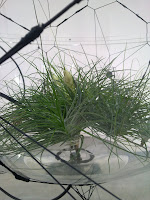












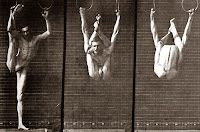
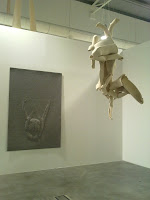

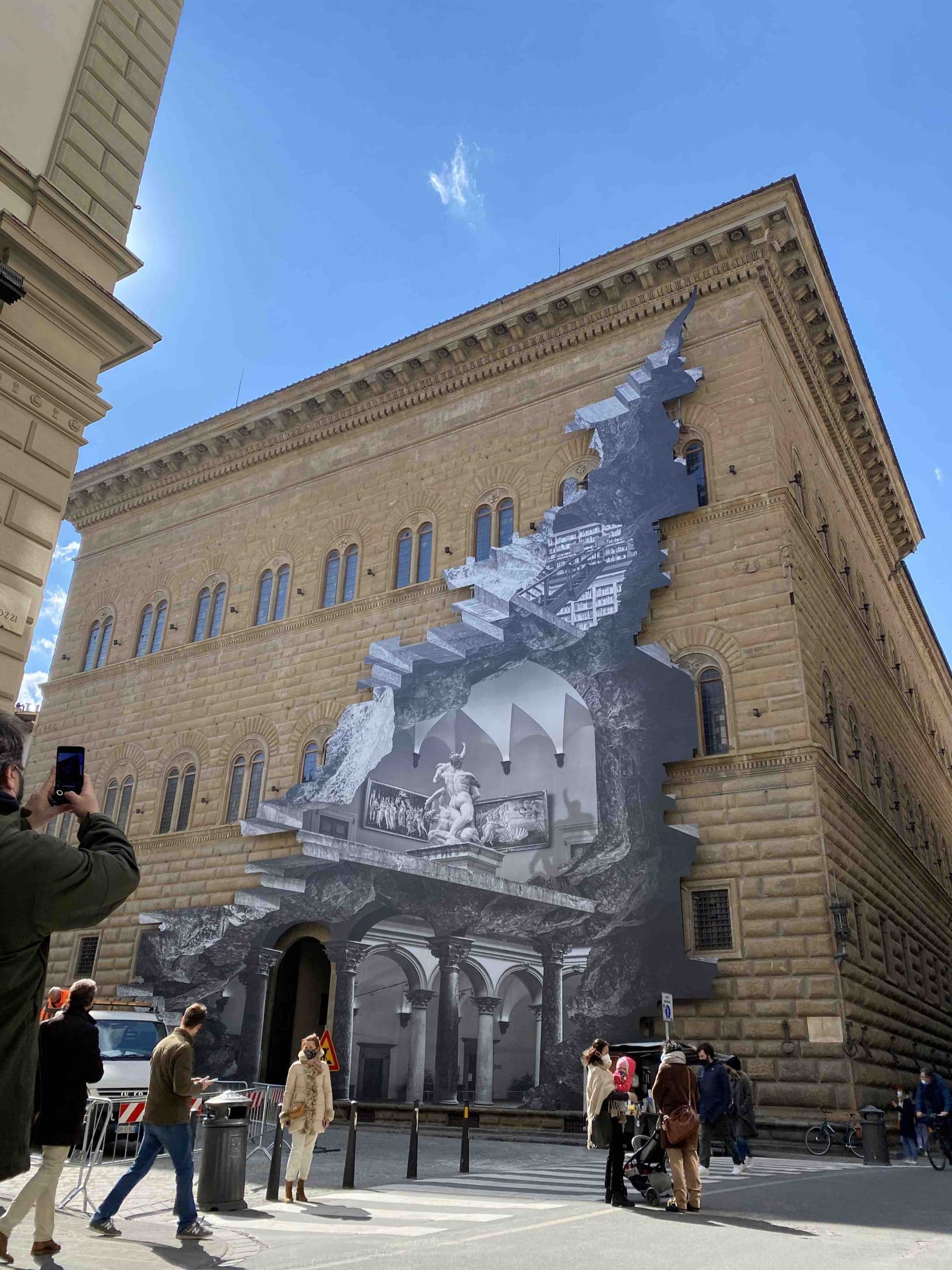
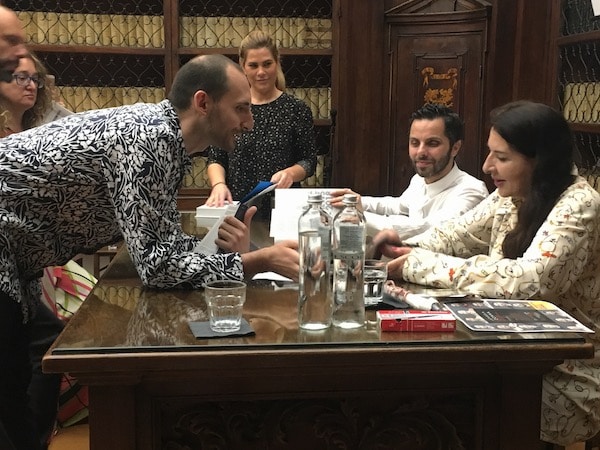
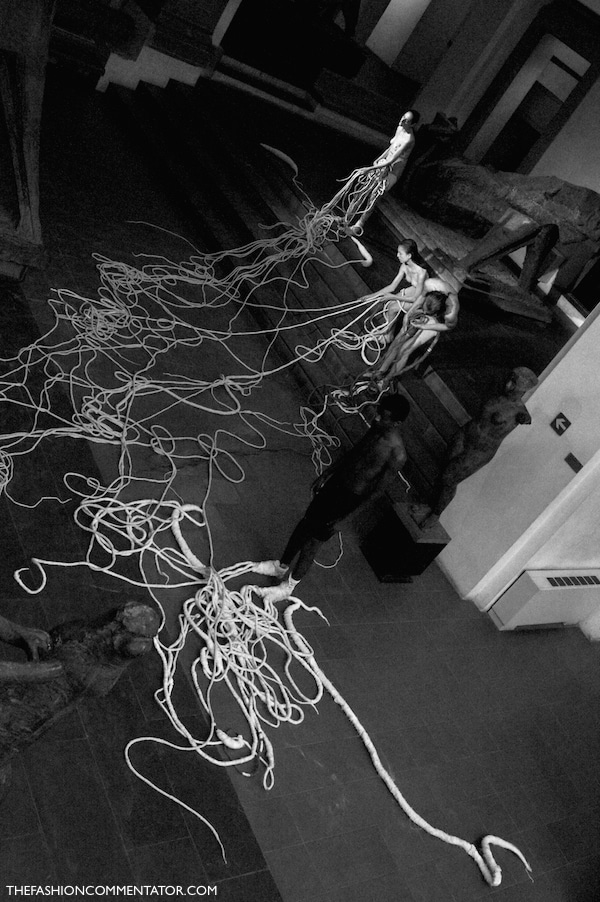
a me la mostra è piaciuta tantissimo! Sono curiosa di vedere la prossima che dovrebbe iniziare i primi di giugno…